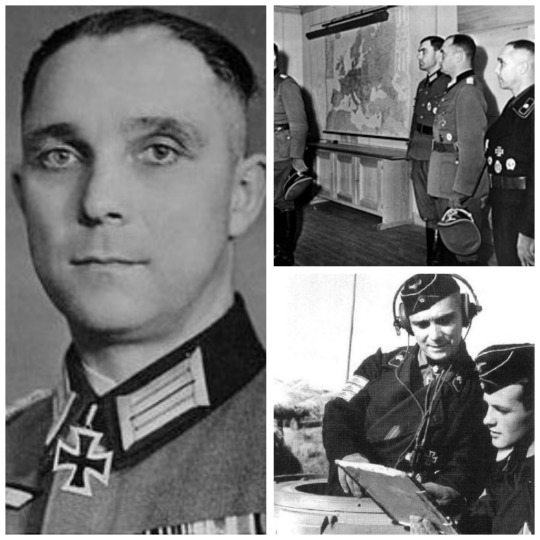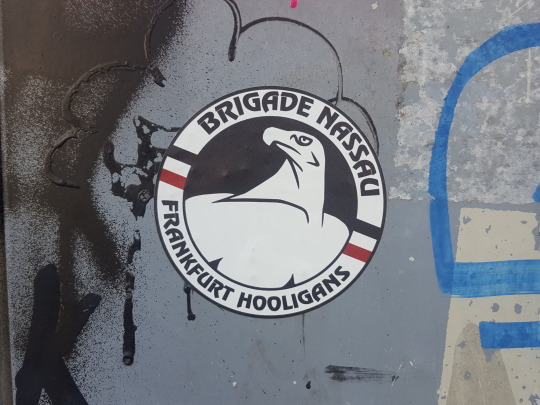#brigade nassau
Photo

Sachsenhausen.
#sge#eintracht frankfurt#eintracht#frankfurt#streetart#graffiti#bn96#hooligans#brigade nassau#uf97#ultras#ultras frankfurt#sachsenhausen
17 notes
·
View notes
Text
Fire damages basement at commercial building on Mortimer Street
Firefighters tackled a blaze in a basement on Mortimer Street. Photo: London Fire Brigade.
Six fire engines and around 40 firefighters tackled a fire at a commercial building on Mortimer Street near the junction with Nassau Street during the early evening of Monday 13 November.
“Part of a room at basement-level was damaged by fire. There were no reports of any injuries,” said a spokesperson for…

View On WordPress
0 notes
Text
Four O’Clock In The Afternoon
Volume 2: Cosette; Book 1: Waterloo; Chapter 6: Four O’Clock In The Afternoon
Towards four o’clock the condition of the English army was serious. The Prince of Orange was in command of the centre, Hill of the right wing, Picton of the left wing. The Prince of Orange, desperate and intrepid, shouted to the Hollando-Belgians: “Nassau! Brunswick! Never retreat!” Hill, having been weakened, had come up to the support of Wellington; Picton was dead. At the very moment when the English had captured from the French the flag of the 105th of the line, the French had killed the English general, Picton, with a bullet through the head. The battle had, for Wellington, two bases of action, Hougomont and La Haie-Sainte; Hougomont still held out, but was on fire; La Haie-Sainte was taken. Of the German battalion which defended it, only forty-two men survived; all the officers, except five, were either dead or captured. Three thousand combatants had been massacred in that barn. A sergeant of the English Guards, the foremost boxer in England, reputed invulnerable by his companions, had been killed there by a little French drummer-boy. Baring had been dislodged, Alten put to the sword. Many flags had been lost, one from Alten’s division, and one from the battalion of Lunenburg, carried by a prince of the house of Deux-Ponts. The Scotch Grays no longer existed; Ponsonby’s great dragoons had been hacked to pieces. That valiant cavalry had bent beneath the lancers of Bro and beneath the cuirassiers of Travers; out of twelve hundred horses, six hundred remained; out of three lieutenant-colonels, two lay on the earth,—Hamilton wounded, Mater slain. Ponsonby had fallen, riddled by seven lance-thrusts. Gordon was dead. Marsh was dead. Two divisions, the fifth and the sixth, had been annihilated.
Hougomont injured, La Haie-Sainte taken, there now existed but one rallying-point, the centre. That point still held firm. Wellington reinforced it. He summoned thither Hill, who was at Merle-Braine; he summoned Chassé, who was at Braine-l’Alleud.
The centre of the English army, rather concave, very dense, and very compact, was strongly posted. It occupied the plateau of Mont-Saint-Jean, having behind it the village, and in front of it the slope, which was tolerably steep then. It rested on that stout stone dwelling which at that time belonged to the domain of Nivelles, and which marks the intersection of the roads—a pile of the sixteenth century, and so robust that the cannon-balls rebounded from it without injuring it. All about the plateau the English had cut the hedges here and there, made embrasures in the hawthorn-trees, thrust the throat of a cannon between two branches, embattled the shrubs. There artillery was ambushed in the brushwood. This punic labor, incontestably authorized by war, which permits traps, was so well done, that Haxo, who had been despatched by the Emperor at nine o’clock in the morning to reconnoitre the enemy’s batteries, had discovered nothing of it, and had returned and reported to Napoleon that there were no obstacles except the two barricades which barred the road to Nivelles and to Genappe. It was at the season when the grain is tall; on the edge of the plateau a battalion of Kempt’s brigade, the 95th, armed with carabines, was concealed in the tall wheat.
Thus assured and buttressed, the centre of the Anglo-Dutch army was well posted. The peril of this position lay in the forest of Soignes, then adjoining the field of battle, and intersected by the ponds of Groenendael and Boitsfort. An army could not retreat thither without dissolving; the regiments would have broken up immediately there. The artillery would have been lost among the morasses. The retreat, according to many a man versed in the art,—though it is disputed by others,—would have been a disorganized flight.
To this centre, Wellington added one of Chassé’s brigades taken from the right wing, and one of Wincke’s brigades taken from the left wing, plus Clinton’s division. To his English, to the regiments of Halkett, to the brigades of Mitchell, to the guards of Maitland, he gave as reinforcements and aids, the infantry of Brunswick, Nassau’s contingent, Kielmansegg’s Hanoverians, and Ompteda’s Germans. This placed twenty-six battalions under his hand. The right wing, as Charras says, was thrown back on the centre. An enormous battery was masked by sacks of earth at the spot where there now stands what is called the “Museum of Waterloo.” Besides this, Wellington had, behind a rise in the ground, Somerset’s Dragoon Guards, fourteen hundred horse strong. It was the remaining half of the justly celebrated English cavalry. Ponsonby destroyed, Somerset remained.
The battery, which, if completed, would have been almost a redoubt, was ranged behind a very low garden wall, backed up with a coating of bags of sand and a large slope of earth. This work was not finished; there had been no time to make a palisade for it.
Wellington, uneasy but impassive, was on horseback, and there remained the whole day in the same attitude, a little in advance of the old mill of Mont-Saint-Jean, which is still in existence, beneath an elm, which an Englishman, an enthusiastic vandal, purchased later on for two hundred francs, cut down, and carried off. Wellington was coldly heroic. The bullets rained about him. His aide-de-camp, Gordon, fell at his side. Lord Hill, pointing to a shell which had burst, said to him: “My lord, what are your orders in case you are killed?” “To do like me,” replied Wellington. To Clinton he said laconically, “To hold this spot to the last man.” The day was evidently turning out ill. Wellington shouted to his old companions of Talavera, of Vittoria, of Salamanca: “Boys, can retreat be thought of? Think of old England!”
Towards four o’clock, the English line drew back. Suddenly nothing was visible on the crest of the plateau except the artillery and the sharpshooters; the rest had disappeared: the regiments, dislodged by the shells and the French bullets, retreated into the bottom, now intersected by the back road of the farm of Mont-Saint-Jean; a retrograde movement took place, the English front hid itself, Wellington drew back. “The beginning of retreat!” cried Napoleon.
1 note
·
View note
Text

• Franz Bäke
Franz Bäke was a German officer and tank commander during World War II. In post-war popular culture, Bäke is considered one of the "panzer aces", that is, a highly decorated German tank commander.
Born February 28th, 1898 in the Province of Hesse-Nassau, German Empire. Bäke volunteered for the German Army in May 1915 and was posted to an infantry regiment. Fighting on the Western Front, Bäke earned the Iron Cross 2nd Class in 1916. Bäke was discharged from military service in January 1919. From 1919 to 1921, Bäke served in the Freikorps Epp, a right-wing paramilitary unit named after Franz Ritter von Epp. In parallel, he studied medicine and dentistry and attained degree of Doctor of Medical Dentistry in 1923. On March 1st, 1933, Bäke joined the SA; his final rank within the SA was SA-Standartenführer as of August 1944. Bäke established his own dentistry practice in Hagen. In 1937 he was accepted into the reserves and was posted to a reconnaissance unit. In 1938, he was mobilized for full-time service as an officer and took part in the occupation of Czechoslovakia.
Bäke's unit took part in the invasion of Poland as part of the 1st Light Division, which was redesignated 6th Panzer Division in October 1939. With this unit, Bäke took part in the Battle of France and Operation Barbarossa. Following the encirclement of the German 6th Army at Stalingrad, the division took part in the abortive attempt to relieve the 6th Army in Operation Winter Storm in December 1942 and then retreated to Kharkov. In January 1943, Bäke was awarded the Knight's Cross of the Iron Cross. During the Battle of Kursk (Operation Citadel) in July 1943, Bäke's unit fought near Belgorod, retreating to the Dniepr afterwards. For his actions during Operation Citadel, Bäke was awarded the Oak Leaves to the Knight's Cross.
On November 1st, 1943, Bäke was appointed as a regimental commander. In December 1943, he was ordered to form an ad hoc reinforced tank regiment named Heavy Panzer Regiment Bäke. The regiment consisted of 46 Panther and 34 Tiger I tanks, supported by self-propelled artillery and a mechanized engineer battalion. In January 1944, Bäke commanded his regiment during the battles for the Balabonovka pocket. Bäke single-handedly destroyed three Soviet tanks during the battle with infantry weapons at close range, for which he received three Tank Destruction Badges. Next, the regiment was part of a relief effort in support of Group Stemmermann, encircled in the Cherkassy Pocket. For his actions during these battles, Bäke received the Swords to the Knight's Cross on February 21st, 1944. In March, the regiment fought in the Kamenets-Podolsky pocket. In May 1944, Bäke was promoted to Oberst and later appointed commander of Panzer Brigade Feldherrnhalle. Bäke's unit attacked the U.S. 90th Infantry Division near Aumetz on the night of September 8th, 1944. Bäke's command found itself poorly deployed and under sustained counter-attack from American infantry. By the evening of September 8th, Bäke had lost thirty tanks, sixty half-tracks, and nearly a hundred other vehicles in the lopsided battle. His infantry losses were also heavy, with the unit reporting to OB West that it had only nine armored vehicles and that unit strength was down to 25 per cent of the authorized establishment. On February 28th, 1945, Bäke transferred from reserve to active duty. On March 10th he was appointed commander of Panzer Division Feldherrnhalle 2, formally the 13th Panzer Division, and sent to Hungary. Bäke's division fought as part of the Panzer Corps Feldherrnhalle during the retreat through Hungary and Czechoslovakia. On April 20th, Bäke was promoted to Generalmajor and officially given command of the division. On May 8th, 1945 he surrendered to American forces. Bäke was interned for two years; he was released in 1947. He returned to Hagen and resumed his dental practice. He died in December 1978 at the age of 80 in Bochum, West Germany.
Bäke is one of the "Panzer aces", that is, highly decorated tank commanders popularised by the German author Franz Kurowski in his 1992 book Panzer Aces, along with Kurt Knispel and Michael Wittmann. In Kurowski's retelling of the operation to relieve the Cherkassy Pocket, Bäke is able to establish a corridor to the trapped German forces, after fighting unit after unit of the Red Army. Kurowski writes: "when the Soviets launched their expected attack, they were wiped out by the exhausted Panzer soldiers". In another of Kurowski's accounts, while attempting to relieve the 6th Army encircled in Stalingrad, Bäke destroys 32 enemy tanks in a single engagement. Military historian Steven Zaloga uses the term "tank ace" in quotation marks in his 2015 work Armored Champion: The Top Tanks of World War II. Zaloga points out that most of the supposed panzer aces operated the Tiger I heavy tank on the Eastern Front; having advantages both in firepower and in armor, Tiger I was "nearly invulnerable in a frontal engagement" against any of the Soviet tanks of that time. A crew operating a Tiger could thus engage its opponents from a safe distance. During World War II, Bäke participated in over 400 tank combat missions, 13 of which resulted in the destruction of his tank. He was wounded seven times in combat.
#second world war#world war 2#military history#biography#world war ii#history#german history#tank warfare#tank ace#panzers#german engineering#wwii
20 notes
·
View notes
Text
of the "women of Nassau call you an idiot" brigade I've always thought Eleanor was the weakest strategist; either I'm wrong or this is going to go badly
#i'm pretty sure i've seen spoilers for her eventual fate anyway#i'm talking about this episode specifically like whether it happens now or later#black sails posting
5 notes
·
View notes
Text
Deaths, Permanent and Otherwise
bc my little Romanticist heart loves the way this show uses Symbolic Death As Transformation; I wanna talk about them all and I need a List of them for that
There’s some ambiguity in what exactly counts as a death; I freely admit I’m sort of going with Vibes here. in general, if people are Believed Dead, or otherwise disappear from the world in some way, I count it; there are other cases though, I’ll asterisk bc it’s Weird--feel free to ask me about it if any of them seem to need explaining! Permanent deaths are in bold. I’m going to try to break it down by seasons.
Also, I’m not even going to try and track the Redshirt Brigade or characters who aren’t around for more than an episode or two before dying, etc; this is about death as arc-changer, so I’m sticking to characters who get arcs (and also, have you seen how many people die?? I’d be here all week). But with those caveats, I am trying to remember them all--if you see one I missed, let me know, I’ll add it in!
Spoilers obviously!!
S1:
Silver*
Max*
Vane
Dufresne
Billy
Gates
The crew of the Walrus And Also Silver *
S2
Jack & Anne
Pre-show/ S2 Reveal:James McGraw, Miranada Hamilton, Thomas Hamilton
Miranda
Flint
Silver*
S3
Eleanor
the entire crew of the Walrus again , incl. Flint, Silver, and Billy
Mr Scott
Dufresne
Vane
Hornigold
S4
oh just absolutely everybody damn
seriously though:
Nassau
Teach
Billy (x2)
Anne
Eleanor
Madi
the Walrus and crew,one more last time
Flint* ( I’ve come to learn this a Vexed Question to the fandom; however, it’s not one that I find particularly compelling to go over. My take is that Flint died,James lived; I’m not going to try and nerf anyone else’s reading of it, but that’s the read I’m always going to be analyzing from.)
4 notes
·
View notes
Photo

Funny How Things Work Out
By ED TRAVIS
Those of us who play golf for the fun of it sometimes wish we could use our Visa card to fix our game not to mention filling in any gaps due to a deficit of talent.
Rather than beating balls on the range or spending hours on the putting green it would be a lot easier to “buy a game.” Just stop in the local golf shop and pick up the latest and greatest carbon-titanium-steel-graphite driver or plumber’s neck-mini-mallet-blade putter. The only problem then becomes keeping the secret from the brother-in-law so Saturday’s $10 Nassau would be a sure thing.
Ideally, our clubs should help rather than hurt our chances of scoring somewhere near our potential. Unfortunately, as with a lot of things, the real-world intervenes and it’s not just the time constraints of our busy lives that clearly puts the task of evaluating clubs in the “unsuited for the uninitiated” category. There is also the feeling one may need a PhD to figure out all the esoteric and often mysterious differences in clubs which assuredly shoves the solution way beyond those of us in the deskbound office brigade.
Let me tell you a story to prove the point.
Living in Florida where 75 million annually vacation provides lots of opportunity to golf with a cross section of fellow strugglers and one afternoon the starter matched me up with a typical husband and wife escaping from the bleakness of a Midwestern winter.
Both were experienced players and the wife, back into the game after a hiatus to raise a couple of kids, teed it up regularly with a group of “girls” at the club back home. Her husband, the quintessential mid-level executive weekend warrior, had a pronounced left to right ball flight which probably meant his favorite courses were not ones with trees lining the left side of the fairway. They were nice people and enjoyable companions for the few hours it takes for this maddening game.
While waiting on the par-3 third hole husband noted my bag had clubs from seven different manufacturers and asked, “What’s that all about?”
The simple explanation was seven manufacturers because the company who made the longest-straightest driver for my swing did not have an iron model that produced the best distance and control. Similar computerized shot analysis sessions put two other wedge brands, a fifth company’s fairway wood and a sixth’s hybrid in my bag. The choice of putter, from still another manufacturer, had been the computer’s second selection since the first choice was distinctly unappealing; in fact if you can picture an ungainly lump on the end of a shaft you would have the idea. Given my decades of playing and writing about the game the importance of custom clubs was beyond question as was the need to reevaluate specifications every couple of years.
The critical point is as we age our swing changes, especially the speed we can generate, and that necessitates changes in our clubs. In my case I now walk right past the “tips” heading for two tees forward and depending on how the body is feeling on any given day, maybe three. This isn’t a complaint simply a realistic assessment by a someone who can no longer play at the level to which he was accustom.
Getting back to our friends and the husband’s question, he told me that back home only a few of his buddies had been through a fitting (most likely the ones worried about that $10 brother-in-law Nassau) but he readily understood the idea of carrying clubs to help not hurt his game.
He even agreed the fee paid to a professional clubfitter makes sense when viewed as a modest investment in your future enjoyment of the game and the question of finding a professional clubfitter was answered by a quick smartphone consultation. There was one less than 10 miles from his home.
At the end of the round we exchanged business cards and promised to stay in touch, but in my mind I’d let a week or so go by and then send an email prompting him about a club fitting appointment.
The temptation was also there to mention how much more his wife would enjoy playing with him if he didn’t offer advice and tips after each swing but then having travelled that particular road myself I figured he could learn to navigate the potholes himself.
Interestingly, while husband was off in the palmettos attempting a recovery from another boomerang-shaped drive, his wife she asked if a fitting would make sense for her. Though we had played only a few holes it was apparent with her basic swing and better than average short game she had the potential to score much lower. After surveying her bag, it was obvious a fitting would help.
Out of curiosity I inquired where she had gotten the stiff shafted irons and steel headed driver, but the reply did not surprise me. When she started playing again husband came home with this bunch of beauties and a, “Here honey, play with these.” He must have gotten a heck of a deal but at least the bag and headcovers were a matching mauve.
This is important. Do not let a friend dictate or even gently steer you toward something they like. The corollary of course is trying your buddy’s new driver and absolutely striping it one time does not mean you’ve found the answer to the maiden’s prayer. Do not stop on the way home to get one just like it ‘cause chances are that one driver swing was the golf gremlins messin’ with you.
Also be cautious of being fit by someone who sells a single brand or a limited number of brands. The truth is even the most knowledgeable best-intentioned fitter can only fit you to the driver or irons for which he has samples. You will never get the chance to try the perfect club if it is not in the shop.
But getting back to the story, a couple of weeks later the husband sent an email saying he had been to the fitting and how surprised he was the club specs had changed starting with a swing weight. Rather than the graphite shafted ultra-lights he had been playing his new clubs were a heavier D-3 swing weight and the driver had a strong draw bias to help straighten out his slice.
His excitement was evident. Another Florida visit had been planned but the timing coincided with the PGA Merchandise Show, so I missed seeing him however a few days after the Show another email arrived.
This one was from the wife, and she was over the moon, writing she had been fitted for clubs as well and also made the trip south. Both of them were happy with the “instant” improvement—hitting the ball farther and straighter. Best of all, she confided, there’s no doubt in her mind she can take her husband on in a $10 Nassau straight up.
Funny how things work out.
4 notes
·
View notes
Text
Ультрас Динамо и Айнтрахта устроили драку на Крещатике
Ультрас Динамо и Айнтрахта устроили драку на Крещатике
Ультрас Динамо / WBC Ультрас Динамо
Фанаты киевского Динамо и соперника Шахтера Айнтрахта имели схватку в Киеве.
В центре Киева произошел “махач” фанатов Динамо и Айнтрахта, сообщает Troublemakers & Ultras Action.
Со стороны “бело-синих” принимали участие 42 человека, которые представляют фирмы Capitals, FBF и North Company, со стороны немцев были 70-80 хулиганов с Brigade Nassau&Ko.
За 5 минут…
View On WordPress
0 notes
Photo

Niederrad.
#sge#eintracht frankfurt#eintracht#frankfurt#streetart#sticker#aufkleber#adler#per sempre#bn96#brigade nassau#hooligans#niederrad
4 notes
·
View notes
Photo

Römerstadt.
#sge#eintracht frankfurt#eintracht#frankfurt#streetart#sticker#aufkleber#adler#uf97#ultras#ultras frankfurt#bn96#brigade nassau#hooligans#europapokalsieger#stadtwald bagaasch#römerstadt
4 notes
·
View notes
Photo

Ostend.
#sge#eintracht frankfurt#eintracht#frankfurt#streetart#sticker#aufkleber#adler#bn#brigade nassau#hooligans#ostend
4 notes
·
View notes
Photo

Niddapark.
#sge#eintracht frankfurt#eintracht#frankfurt#streetart#graffiti#uf97#ultras#ultras frankfurt#bn96#brigade nassau#hooligans#niddapark
6 notes
·
View notes
Photo

Ostend.
#sge#eintracht frankfurt#eintracht#frankfurt#streetart#sticker#aufkleber#adler#bn96#brigade nassau#frankfurt hooligans#ostend
3 notes
·
View notes
Photo

Berkersheim.
#sge#eintracht frankfurt#eintracht#frankfurt#streetart#graffiti#adler#uf97#ultras#ultras frankfurt#bn96#brigade nassau#hooligans#berkersheim
2 notes
·
View notes
Photo

Bockenheim.
#sge#eintracht frankfurt#eintracht#frankfurt#streetart#sticker#aufkleber#adler#bn96#brigade nassau#hooligans#europa tour#bockenheim
3 notes
·
View notes
Photo

Riederwald.
#sge#eintracht frankfurt#eintracht#frankfurt#streetart#graffiti#bn96#hooligans#brigade nassau#riederwald
4 notes
·
View notes